News Summary
Students at the University of Charlotte are confronting serious health risks due to asbestos in Sanford Hall, with alarming levels detected in recent tests.
The Ongoing Asbestos Crisis at University of Charlotte’s Sanford Hall
As the sun shines brightly in Charlotte, North Carolina, with temperatures soaring to a high of 74°F on this clear February morning, there’s a shadow cast over the University of Charlotte. Despite the pleasant weather, students living in Sanford Hall confront an unnerving reality – the looming threat of asbestos exposure.
History of Asbestos in Sanford Hall
Identified back in 2013, asbestos-containing materials (ACM) have existed in Sanford Hall for over a decade. Asbestos, a notorious cancer-causing chemical, has been banned in more than 50 countries, yet it still remains legal within various components of buildings throughout the United States. The University of Charlotte, however, has faced no legal obligation to abate or remove this toxic irritant from its facilities.
In a shocking revelation, an asbestos report conducted in 2024 found that 172 out of 371 material samples from Sanford Hall were ACM. These samples contained varying levels of asbestos, with some materials displaying an alarmingly high concentration—up to 65 times more asbestos than what the Occupational Safety and Health Administration (OSHA) classifies as an ACM.
Regulatory Gaps and Student Safety
In stark contrast to public schools, which received funding under the Asbestos School Hazard Abatement Reauthorization Act (ASHARA) established in 1990 for planning and removing ACM, public universities like UNC Charlotte remain unprotected by the same mandates. This regulatory gap allowed Sanford Hall to facilitate two significant renovation projects wherein the asbestos floor tiles were simply covered up rather than removed, demonstrating a lack of proactive measures in place to safeguard the health of students.
For over 50 years, Sanford Hall has stood as a residence, coinciding with a surge in university expansion and a growing demand for on-campus housing. But the question surfaces: Was enough attention given to the safety risks posed by the building’s materials? The community has become increasingly concerned about the lack of transparency regarding the presence of asbestos, leading to a breakdown of trust between students and the administration.
A Need for Communication and Trust
Effective communication regarding hazardous materials is paramount in building trust within a community. The University of Charlotte stands at a crossroads; without trust, it risks alienation from its students. The absence of a clear and comprehensive plan to eliminate asbestos altogether raises criticism of the University’s transparency and commitment to student safety, echoing an alarming metaphor—Sanford Hall is often referred to as a “dying dorm.”
The essential role of any university extends beyond just education; it includes being a source of leadership and influence in its community. The fallout from the asbestos crisis at Sanford Hall could overshadow the University of Charlotte’s reputation if they fail to address the issue suitably. By adopting a proactive approach towards asbestos management, the University could not only enhance its reputation but also foster trust with its student body.
Conclusion: The Future of Sanford Hall
As greater scrutiny surrounds Sanford Hall and the wider implications of the asbestos crisis, students from all walks of life are profoundly impacted. The pathway to a brighter future involves a commitment from the University not only to ensure compliance with health regulations but also to prioritize the safety and well-being of its students. The clock is ticking for Sanford Hall. Will the University of Charlotte rise to the occasion or continue to sit idly by as a deadly dust cloud looms overhead?
Deeper Dive: News & Info About This Topic
HERE Resources
California Couple Takes Legal Stand Against Asbestos Companies
Flint Cooper’s Legal Team Grows to Combat Asbestos Epidemic
Alerts at Lampeter-Strasburg School Board Meeting: Asbestos Discovery Raises Concerns
Asbestos: The Toxic Carcinogen Strikes Again as U.S. Implements Phased Ban
U-Haul Faces Hefty Fine Over Asbestos Exposure During Renovation
Rising Concern Over Mesothelioma Cases Linked to Asbestos Exposure
Inquest Begins into Asbestos-Related Death of 90-Year-Old
Acorn Analytical Services Expands Workforce Amid Growing Demand for Asbestos Management
Johnson & Johnson’s Bankruptcy Hearing Unfolds Amidst Cancer Lawsuits
Asbestos Concerns Rise: Austin City Officials Take Action



















